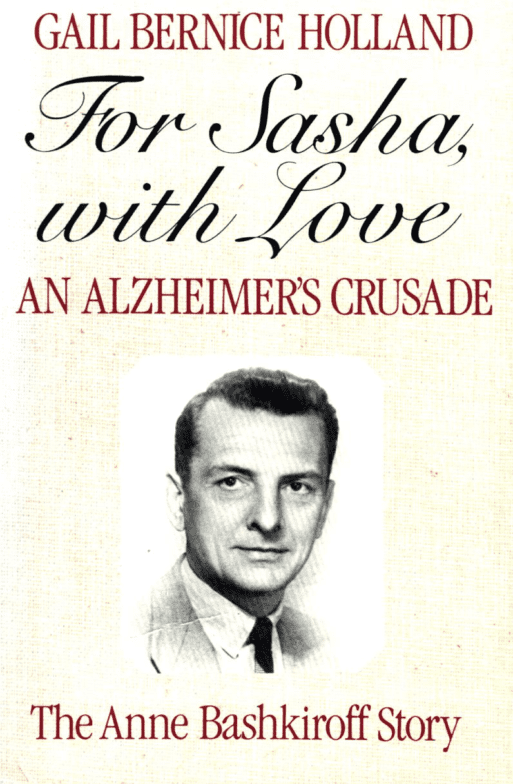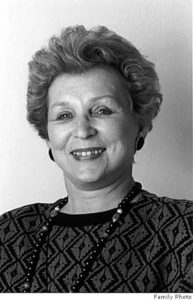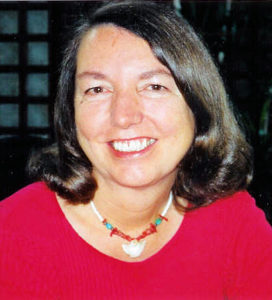 “For Sasha, with Love, An Alzheimer’s Crusade, The Anne Bashkiroff Story” is a significant book on the history of dementia in the United States. It brought much-needed attention to Alzheimer’s disease back in 1977, a time when the disease was virtually unknown to the average person. With the help of Rosalynn Carter, Anne Bashkiroff presented the story of her husband Sasha’s illness and the enormous difficulties she faced to the President’s Commission on Mental Health. She personally demanded that the government do something for all brain-damaged people.
“For Sasha, with Love, An Alzheimer’s Crusade, The Anne Bashkiroff Story” is a significant book on the history of dementia in the United States. It brought much-needed attention to Alzheimer’s disease back in 1977, a time when the disease was virtually unknown to the average person. With the help of Rosalynn Carter, Anne Bashkiroff presented the story of her husband Sasha’s illness and the enormous difficulties she faced to the President’s Commission on Mental Health. She personally demanded that the government do something for all brain-damaged people.
The book exposed for the first time the depth of despair experienced by those caring for a loved one suffering from dementia. Prior to “For Sasha with Love,” dementia was simply called “being senile.” Author Gail Bernice Holland, a feature writer at the San Francisco Examiner at the time, tells Anne Bashkiroff’s painfully honest story of her husband’s deterioration, including her struggles with finances and how difficult it was to get care for him, let alone affordable care.
A Brief Biography
The book is written in two parts. In the first part, the author reveals the story of Anne and Sasha’s family backgrounds, starting with the details of their grandparents as children. I admit I started the book interested only in Sasha’s story as it related to dementia. But once I accepted the author’s reason for writing about the family history, I did enjoy part one. It allows the reader to get to know Sasha before he became ill. Nonetheless, it’s written almost like two different books.
In part one the reader learns that Sasha’s grandfather and father were born into Russian wealth — wealth so great that his family never did visit all of the family’s estates. The Russian revolution destroyed the possibility of Sasha also having a privileged life, forcing him to flee Russia as a young teen. Holland relates a great deal of detail about the journey that finally lands Sasha in the United States as a young man.
Along the way he meets Anne. When she first lays eyes on him, she finds him dark and handsome, having no reservations about the fact that he is 20 years older then she. Later in part two, the age difference becomes the catalyst to Anne’s unique journey — a journey that subsequently lands her before the President’s Commission on Mental Health.
Early Warning Signs
Part two jumps right into Sasha’s first signs of Alzheimer’s at the age of 65. He has just retired from his 18 years with The American Can Company in San Francisco. His boss and a colleague pay him a visit at his home to bring him his things from the office, along with a retirement gift and a card signed by 50 co-workers. Sasha sits staring blankly and non-responsive, as if he has never met either of them before. It’s an embarrassing and uncomfortable situation for both Anne and the visitors.
Sasha’s energy begins to diminish, and he lacks interest in any kind of work. He sits around the house in a detached, trance-like state much of the time. We begin to witness Anne’s slow journey through the puzzling signs of what, back then, was the unknown disease of dementia.
As the signs of dementia advance, we experience Anne Bashkiroff’s frustration, fear and confusion first hand. She unexpectedly finds herself the sole income earner, living in fear while Sasha does crazy things. One day, Sasha tosses his expensive hat out the car window for no apparent reason. Not long after that, he pours orange juice in the coffee maker. On another day he hangs saucepans on the laundry line, and on still another he hoses down the sidewalk in the rain. When her neighbor witnesses some of this bizarre behavior, Anne is too embarrassed to tell her about her husband’s decline.
“For Sasha, with Love, An Alzheimer’s Crusade,” is an easy read. It drew me into Anne’s life and allowed me to experience exactly what it was like to live day-to-day with a husband with progressive Alzheimer’s disease. It was especially interesting (given the time period) how much in the dark she was as to what was happening with Sasha. Even after learning of the diagnosis, she was still clueless as to how bad things would get. The book gives heartbreaking insight into how misunderstood dementia was back in the 70s (though it wasn’t really that long ago). I also had no idea there was such a stigma attached to it that spouses like Anne chose to hide it from friends.
Searching for Answers
Bashinoff takes Sasha to many doctors until one finally suggests a neurologist. Anne is frustrated with how each physician treats her husband. But the neurologist is the one who throws “a bucket of ice-cold water” over her head with a blunt, two-word diagnosis of “presenile dementia.” She is left reeling, and points out the unfeeling, inhumane way the medical system deals with such situations. At one point she says “they seemed to treat him as if he were a machine that had broken down, a machine to be placed in storage because he was no longer of any use to society.”
Anne finds herself speaking to her husband in ways she never had before. As a woman whose husband cared for her, the role reversal leaves her despondent. She even tricks Sasha into seeing doctors without telling him he has dementia. When she looks back, she admits this was one of her greatest mistakes and something she deeply regrets.
Their friends are uncomfortable around Sasha, so Anne and Sasha become socially isolated. Anne also lives in fear of her once-intelligent husband being ridiculed, so is content to stay away. Not wanting to take away her husband’s independence, she allows him to drive for way too long until he finally has a small accident. But it’s not until he fails the driver’s test twice that he actually loses his license.
Anne finally decides to put Sasha in a nursing home, a difficult decision for her and her college-age son, Nicky. Sasha has become so difficult to handle he gets discharged over and over again. Her finances are drained and her relationship with her son is pulled apart by the family tragedy.
As the years wear on, Anne honestly opens up about her need for intimacy, given Sasha no longer knows who she is. After 29 years of marriage, she meets a man named George and begins a relationship that will last for years. She is as giddy as a schoolgirl buying sheets and a robe for her first night with him.
Moving Towards Advocacy
But the strain of Sasha’s illness still wears on her, and Anne nears the end of her rope. Then a doctor connects her to the Family Survival Project, a group that advocated for brain-damaged adults. Anne joined the group, and on September 27, 1979, Governor Jerry Brown signed California Assembly Bill 1043, which established a program for brain-damaged victims and their families. Anne is still left with “disturbing memories” — the lies she told her husband; the arguments with her son; and blunders and misjudgments she made along the way. But the legislation and her work with the Family Survival Project help give meaning to what she went through.
“For Sasha, with Love” is one part the story of a loving family, one part a tale of how Alzheimer’s progresses, and one part a history of how attitudes and treatments for people with dementia have changed. Anne Bashkiroff was a strong, smart woman who gave all she had to her family and to then help other families. This book is her legacy.

 “For Sasha with Love, An Alzheimer’s Crusade” by Gale Bernice Holland
“For Sasha with Love, An Alzheimer’s Crusade” by Gale Bernice Holland




 First the Wealth Gap, Now the U.S. Has a Growing Health Gap
First the Wealth Gap, Now the U.S. Has a Growing Health Gap
 How to Comfort A Dying Loved One
How to Comfort A Dying Loved One
 Our Annual Seven Holiday Gifts for Someone Who Is Grieving, 2024 Edition
Our Annual Seven Holiday Gifts for Someone Who Is Grieving, 2024 Edition














